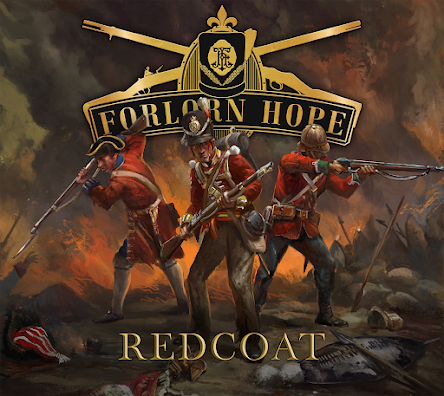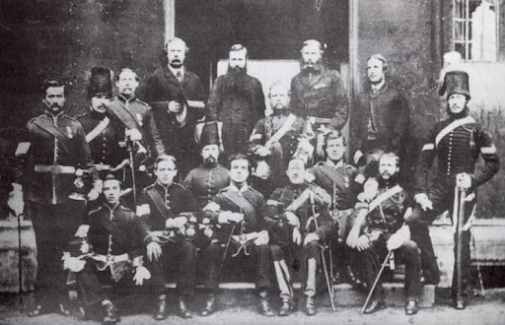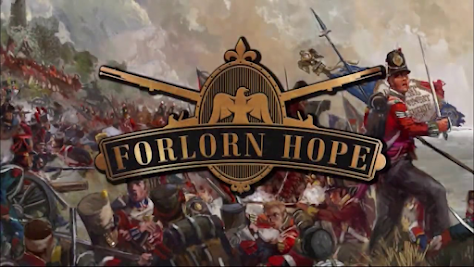The year is 1879. Queen Victoria has reigned for forty-two years over the vast British Empire, the largest the world has ever seen. The Romans, Mongols, Hans, Spanish, and our longest-running nemeses, the French, paled in comparison. Covering a quarter of the world and encompassing a third of its population, the sun never sets. Rule Britannia, Britannia rule the waves ... is more than mere patriotic verse. Since Trafalgar, seventy-four years ago, when Admiral Lord Nelson gave his life completely thrashing the combined French and Spanish fleets, the Royal Navy has been undisputed master of the seas. The Union Flag flies on every continent. (Note: The term Union Jack only applies when the flag is flown from the jackstaff of a ship)

Admittedly, there has been a recent spot of trouble in Southern Africa. The high commissioner, Sir Henry Bartle-Frere, started a fight with our longtime trading partners, the Zulus, without asking Her Majesty or the government. The commanding general, Lord Chelmsford, was also involved, but we won't concern ourselves with him too much. He is friends with the Queen, after all, so we'll just blame Bartle-Frere for anything that goes wrong. Honestly, this would not have caused much bother, except no one expected the Zulus would actually fight back! Of the three columns Chelmsford invaded with, one was decimated at a remote mountain called Isandlwana (does anyone actually know how to spell that?), and another is under siege at an abandoned missionary outpost near the coast.
Crikey, now we have to scrounge up thousands of reinforcements to sort this mess! Do we know if General Wolseley is available, or is he still on his 'working holiday' in Cyprus? Amongst the reinforcements, the 91st Highlanders are so under-strength they had to accept volunteers from across eleven regiments to fill out their ranks. A disproportionate number of these are eighteen to twenty-year-old recruits fresh out of training. Let us hope they're fit! Conditions in the Cape Colonies are rough, and those wool uniforms don't exactly keep one cool in the South African heat! Thankfully, Queen's Regulations and Orders for the Army (1873), has an entire chapter on Gymnastics Training, so the lads should be in descent fighting shape ...
91st Highlanders on the march in Zululand, 1879
It wasn't always like this, though. During the Crimean War (1853 - 1856), 22,000 British soldiers and sailors gave their lives. Of our dead over 17,000 (80%!) were lost, not to enemy guns, but all manner of disease! (something tells me we should have kept the peninsula after all the trouble we went through, and not let the Russians have it back, but I digress...)
Three years later, the War Office commissioned Colonel Frederick Hamilton and Dr. Thomas Logan, Inspector General of Hospitals, to review the fitness training of Prussian and French armies. Given French fatalities from disease in Crimea were nearly as bad as ours (78%), I'm not sure they were the best example. The Ottomans' were 54%, so maybe we should have asked them. Regardless, the report found the Prussians and French had instituted regular gymnastics training since the early 1840s, and on the whole their soldiers were healthier and fitter. The French even founded a centralised training school centred on physical fitness in 1852.
Hamilton sought out Major Frederick Hammersley, who'd served as a company commander with the 14th West Yorkshire Regiment, then later Deputy Assistant Quarter-Master General in Crimea. He was well acquainted with the health and sickness issues of the Army. In 1860, Hammersley was named Inspector of Gymnasia and tasked with establishing the military's physical fitness program at Aldershot. For his instructor staff, he selected twelve non-commissioned officers (NCOs): soldiers in leadership positions between the ranks of corporal and sergeant major. Hammersley wanted men of average stature and conditioning, to better judge how effective the program would be on the average Tommy Atkins. He also needed men of sound mind, who would make the best instructors. Because NCOs had to be literate, they were expected to possess some degree of education. The men selected were cheekily nicknamed The Twelve Apostles.
Not wishing to reinvent the wheel, Hammersley enlisted the aid of Archibald MacLaren, a famous gymnast, competitive fencer, and educator. MacLaren established a highly reputable gymnasium at Oxford University two years before.
Archibald MacLaren (1820 - 1884)
Hammersley and the Twelve Apostles underwent a year-long program under MacLaren's strict instruction. Focus was on practical fitness, rather than aesthetics or what later generations would think of as bodybuilding. While the sport of fencing was sometimes derided as a gentleman's sport, with little application for the modern soldier, for MacLaren, it was a staple of his training regime. Fencing taught agility, hand-eye coordination, mobility, and balance. Long practice sessions greatly increased lung capacity and muscular endurance. Callisthenics, such as stretching, mobility exercises, press-ups, squats, and even weight training were incorporated into the regime. Weights consisted mostly of crude dumbbells. There were no squat racks, nor straight bars that you could add or remove plates from. The human body and surrounding environment provided the tools for resistance training.
As seen in the sketch below, the Oxford Gymnasium had plenty of obstacles to train both strength and stamina. Victorians were training for a Spartan Race 150 years before Spartan Race existed!
The Oxford Gymnasium, from the Illustrated London News (1859)
It is not recorded what changes, if any, were made to their nutrition. It's likely Hammersley and his NCOs maintained their usual diet. The goal was to demonstrate how the average soldier could improve their health and conditioning through gymnastics training alone. Side note: Gymnastics is the period term for physical fitness training and does not mean the Olympic sports, though a lot of those were incorporated.
We can see the benefits of MacLaren's training on Major Hammersley, who is holding the weight of five men on his back. A pity we can't see his legs, if his arms are anything to go by. I wonder if there was a Victorian term for 'jacked'?
Progress was closely monitored by MacLaren. During the twelve-month course, every man was photographed and his measurements taken. A pity we don't have these 'before and after' photos readily available! The program was deemed an overwhelming success. The candidates were stronger, more muscular, agile, energetic, and far less prone to illness. Hammersley and his NCOs became the first permanent staff of the newly created Army Gymnastic Staff (AGS), now known as the Royal Army Physical Training Corps (RAPTC).
Archibald MacLaren (top left), standing with two assistants and Major Frederick Hammersley (2nd from right), along with the twelve NCOs of the first Army Gymnastics Staff (AGS), renamed the Royal Army Physical Training Corps (RAPTC) in 1940
In 1861, a gymnasium was constructed at Aldershot, based on MacLaren's Oxford model. Regiments were required to send NCOs to train with the AGS to act as gymnastic instructors for their units. When notable improvements were made to overall health and fitness, the Report on Gymnastic Instruction in the Army was approved in 1864, making the program permanent.
Standardised physical training was incorporated into Queen's Regulations and Orders for the Army. Running was crucial, with soldiers expected to run 1,000 yards and still be ready to fight with bayonet at the end. Fencing, and even swimming (called bathing parades) were incorporated into the Army's fitness routine. One hour of gymnastics training, modelled on what MacLaren put Hammersley and his NCOs through, was performed in the early morning on duty days. This still carries into modern times with armies on both sides of the Atlantic and across the old Commonwealth / Empire.
Illnesses and disease fatalities decreased during the later Victorian Era, though were not completely eradicated. Fevers still claimed many lives, particularly in humid, tropical climates the average redcoat was not accustomed to. Air pollution from the Industrial Revolution and rampant tobacco usage weakened lungs and caused other health issues across the globe. Major Gonville Bromhead, the famous Victoria Cross recipient from the Battle of Rorke's Drift (22-23 January 1879) died of typhoid in India at just forty-five. His Rorke's Drift counterpart, Colonel John Chard, VC, was a frequent pipe smoker and died of tongue and throat cancer at just forty-nine. Still, while the AGS fitness programs could not completely eliminate disease, its frequency dropped sharply, with survival rates increasing across the Forces.
There were still military health issues to sort, particularly with hygiene and medical care. Following the Anglo-Zulu War, a nineteen-year-old nurse named Janet Wells began pressing for drastic reforms within the Army Medical Department, including the sterilising of instruments between surgeries and not reusing bloody or otherwise soiled bandages. Her actions contributed to improved medical practices, which by the First World War saw a drastic reduction in surgical infection ... but that is a story for another time.
The Gymnasium at Aldershot, from the Illustrated London News (1868)
Today, both the Oxford and Aldershot Gymnasiums are modern sport and fitness centres. The RAPTC still trains Physical Training Instructors (PTI) for the British Army. The U.S. Army adopted a similar program called Master Fitness Trainer. Among the more famous recent PTI alumni is Dame Kelly Holmes, DBE. Dame Kelly is a two-time Gold Medalist at the 2004 Olympics, two-time Commonwealth Games Gold Medalist, former Army judo champion, retired British Army Sergeant, and honorary Colonel of the Royal Armoured Corps. She was knighted as a Dame Commander of the Order of the British Empire (DBE) in 2005.
Dame Kelly Holmes, DBE, carries on MacLaren, Hammersley, and the AGS legacy
(photo: kellyholmes.co.uk)
***
I'd like to close with a shout-out to Forlorn Hope, a fantastic 'History Metal' band out of Liverpool, who've become one of my recent favourites. Their music is great for getting your pump on at the gym, or while channelling your inner Archibald MacLaren. Through them I've even learned about historical events few have heard of. One example is the
Defence of Frankfurt Trench, during the closing days of the Somme, as told through their song,
To the Bitter End (see link below). They will undoubtedly be referenced in future blogs and newsletters.












Comments
Post a Comment